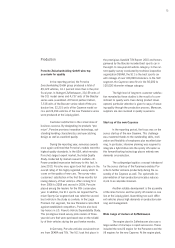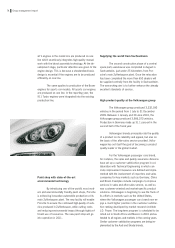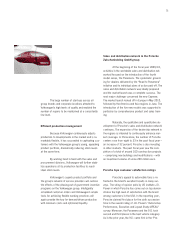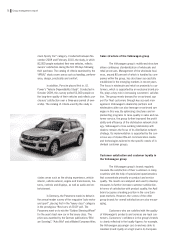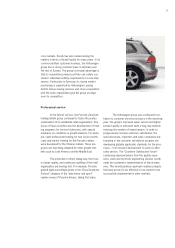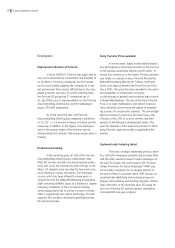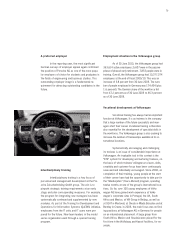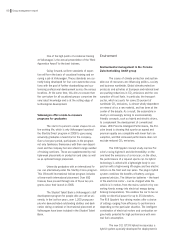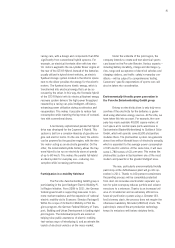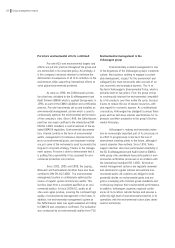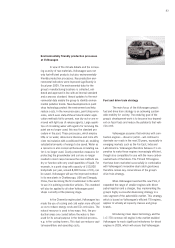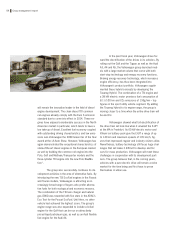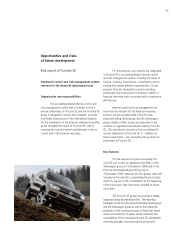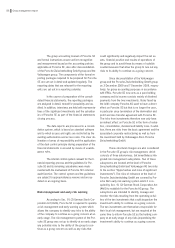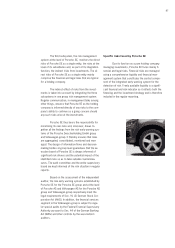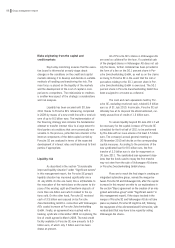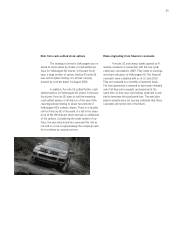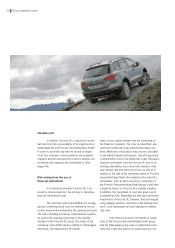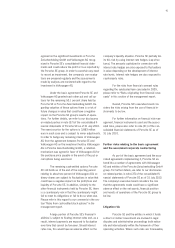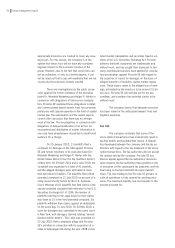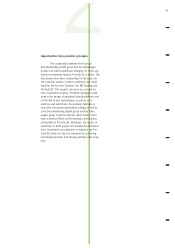Porsche 2009 Annual Report Download - page 83
Download and view the complete annual report
Please find page 83 of the 2009 Porsche annual report below. You can navigate through the pages in the report by either clicking on the pages listed below, or by using the keyword search tool below to find specific information within the annual report.
Fuel and drive train strategy
The main focus of the Volkswagen group’s
fuel and drive train strategy is on achieving sustain-
able mobility for society. The enduring goal of the
group’s development work is to become less depend-
ent on fossil fuels and reduce the pollutants that vehi-
cles emit.
Volkswagen assumes that vehicles with com-
bustion engines – diesel or petrol – will continue to
dominate our roads in the next 20 years, especially in
emerging markets such as the Far East, India and
Latin America. Volkswagen therefore believes it is im-
perative to make these engines increasingly efficient,
though also compatible for use with the more carbon-
neutral fuels of the future. The TSI and TDI engines
that have been marketed successfully in combination
with Volkswagen’s innovative dual clutch gearboxes
therefore remain key cornerstones of the group’s
drive train strategy.
When Volkswagen launched the new Polo, it
expanded the range of smaller engines with direct
petrol injection and a charger, thus implementing the
group’s highly successful downsizing strategy in a
new segment of the automobile market. This strategy,
which is based on Volkswagen’s efficient TSI engines,
applies to virtually all capacity classes and group
brands.
Introducing clean diesel technology and the
1.6 l TDI common rail engine in the market enabled
Volkswagen to reach significant milestones for diesel
engines in 2009, which will ensure that Volkswagen
Environmentally friendly production processes
at Volkswagen
In view of the climate debate and the increas-
ing scarcity of raw materials, Volkswagen uses not
only fuel-efficient products but also environmentally
friendly production processes. Key production envi-
ronmental indicators were improved significantly in
fiscal year 2009. The environmental data for the
group’s manufacturing locations is collected, vali-
dated and approved in line with an internal standard
and a process standard. Annual updates to the envi-
ronmental data enable the group to identify environ-
mental pollution trends. New developments in paint
shop technology protect the environment and help
reduce costs. In the new processes, paint shop emis-
sions, which even state-of-the-art electrostatic appli-
cation methods fail to prevent, now dry out or are re-
moved with light use of release agents. Large quanti-
ties of circulating water with agents for removing the
paint are no longer used; this was the standard pro-
cedure in the past. These processes, which employ
little or no water, allow more intensive and more effi-
cient recirculation with conditioned fresh air, enabling
substantial amounts of energy to be saved. Water as
a resource is also conserved because circulating wa-
ter is no longer used. Costly preventive measures for
protecting the groundwater and soil are no longer
needed in most cases because the new methods are
dry or function with very small quantities of liquid. For
example, in a paint shop with capacity of 150,000
bodyshells per year, around 8,000 tonnes of CO2 can
be saved. Volkswagen will use the improved method
in its new plants in Chattanooga, USA and Chengdu,
China, thus becoming the first automaker in the world
to use it in painting production vehicles. This standard
will also be applied to all other Volkswagen paint
shops currently at the planning stage.
In the Chemnitz engine plant, Volkswagen has
made the use of cooling and cold water more efficient
so as to reduce energy costs and CO2 emissions. The
natural resource is used in two ways: first, the pro-
duction areas are cooled before the water is then
used for its actual purpose in the technical process,
e.g. in the cooling towers. This dual use reduces capi-
tal expenditure and operating costs.
83


